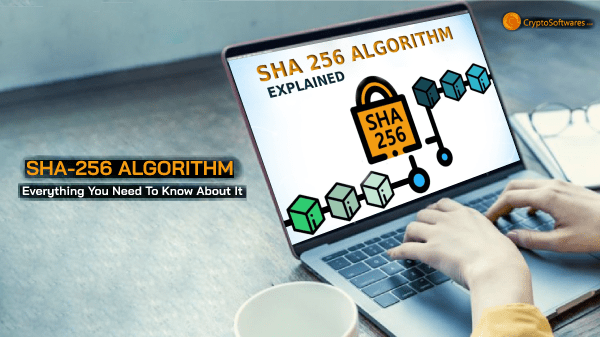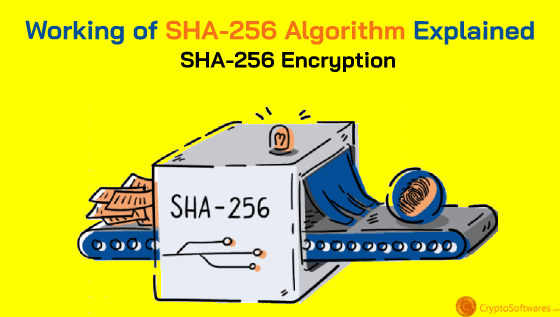
SHA256 Algorithm – Best Cryptocurrency Hashing Algorithm
SubscribeIf you are a cryptocurrency enthusiast, then you might have heard about hashing and hashing algorithms. But what does this have to do with your bitcoin? Or cryptocurrencies in general?
Hashing algorithms are used to make blockchains of cryptocurrencies secure. They are the building blocks of cryptos. The Bitcoin blockchain uses the SHA 256 hash algorithm. We will have a detailed look into SHA256 algorithms. For that, we also need to know what hashing is, what it does in blockchain, and about secure hash algorithms.
What is Hashing?
A hash function is a cryptographic function that takes an input of any length and returns a fixed-length output. This process of using a given hash function to process input is called hashing. The output of that hash function is called a hash.
Characteristics of Hash Functions
For a hash function to be deemed reliable, it should have certain properties. These properties make hash functions fitting for cryptocurrencies. Let’s have a look at these properties.
- Deterministic
- Quick Computation
- Pre-image Resistance
- Randomized
- Collision Resistance
The deterministic property of the hash function is that for a particular input, the output should always be the same.
Another property is that computations should be quick. ie, the hash of any input has to be delivered within a fraction of a second.
Pre-image Resistance means that, from a hash, there is no way that the input can be traced back except for brute force (guessing and trying every possible combination).
The hashes of similar inputs should be vastly different. For example, the hash of inputs “crypto” and “crypto1” should be largely different. Else it would be easier to decrypt the hash.
A collision occurs when different inputs have the same output or hash in the case of a hash function. As hash functions are used to validate crypto transactions worth billions, you can imagine why collisions would not be ideal.
Hashing in Blockchain
Each block in a blockchain represents a transaction. And each transaction has a corresponding hash. To validate a transaction and gain their reward, miners from all over the world try to brute force a 64-digit hash, less than or equal to the target hash. Brute force, as mentioned earlier requires the guessing and trying of possible outcomes. But here the possible outcomes could be in the order of trillions. So no human being or ordinary computer could accomplish this. This is why extensive computing power is required for mining.
A block in a blockchain consists of a timestamp, transaction data, hash of the block, and the hash of the previous block. The blocks are linked together using the hashes. If someone attempts to change a transaction, the hash of that particular block will change. This will not match the “hash of the previous block” in the next block. Thereby breaking the chain.
Different blockchains use different hashing algorithms. Bitcoin employs SHA 256. Dogecoin and Litecoin use Scrypt. We will have a detailed look into SHA-256. Before that let’s see what Secure Hash Algorithms are.
Trending Cryptocurrency Hashing Algorithms 2021
Here we will list some of the top trending Cryptocurrency Hashing Algorithms 2021 to look out for
- SHA-256
- Skein-SHA2
- Scrypt
- X11
- SHA-256d
- NeoScrypt
- Quark
- X13
- Multi-algorithm
- CryptoNight
- Lyra2Z
- Ethash
- X16R
- Equihash 200_9
- Nist5
- CryptoNightV7
- HMQ1725
- Equihash 144_5 (ZHash)
- Qubit
- BLAKE-256
- DaggerHashimoto
- Cunningham chains
- Equihash 210_9
- DEDAL
Secure Hash Algorithm (SHA)- Best Cryptocurrency Hashing Algorithm
SHA or Secure Hash Algorithm was developed by the National Institute of Standards and Technology along with NSA back in 1993. They are typically not considered encryption as they cannot be decrypted back to their original form. Secure Hash Algorithms are widely used in security protocols and applications, including the TLS, PGP, SSL, etc… Types of Secure Hash Algorithms include SHA-0, SHA-1, SHA-2, and SHA-3. Major tech companies such as Google, Microsoft, and Mozilla are recommending the use of SHA-3.
What is SHA256 Hashing Algorithm?
The SHA256 algorithm is part of the SHA-2 family, which also includes SHA-512. It has a higher level of security than its predecessors SHA-0 and SHA-1. While SHA-256 creates a 256-bit hash, SHA-512 creates a 512-bit hash. They also differ in word sizes as hashes are computed using 32-bit and 64-bit words, respectively. The SHA-256 algorithm is one of the most potent hash functions available today. It is not much complex to code than SHA-1 and is yet to be compromised in any way. The 256-bit key also makes it a reliable partner-function for the Advanced Encryption Standard (AES).
In 2009 SHA256 algorithm was implemented in Bitcoin. Soon more cryptocurrencies followed. Today SHA-256 is used in major cryptocurrencies such as BitcoinCash (BCH), 21Coin (21), Peercoin (PPC), Namecoin (NMC), Terracoin (TRC), etc…
SHA256 Algorithm Explained – With Example

A hash calculated using SHA-256 encryption will be 64 characters long and will consist of alphabets a to f and numbers 0 to 9. The 64 character length is because each character holds 4 bits, 64*4 = 256 bits.
Example:
SHA-256 encrypted hash of “abc” ba7816bf8f01cfea414140de5dae2223b00361a396177a9cb410ff61f20015ad
SHA-256 encrypted hash of “123” a665a45920422f9d417e4867efdc4fb8a04a1f3fff1fa07e998e86f7f7a27ae3
Any kind of data including documents, images. videos etc… can be hashed using SHA-256.
There are three reasons which make SHA-256, one of the safest algorithms out there. It is nearly unimaginable to reconstruct initial data from an SHA-256 hash. A chance of different data having the same hash (collision) is highly unlikely. And finally, a small change in the source data causes a big difference in the hash.
Get the best SHA-256 Algorithm Development services with Cryptosoftwares
Conclusion
SHA-256 is one of the safest hash functions existing today. Even the US Government uses it to protect some of their sensitive information.
Many companies continue to use SHA-1 and even MD5, which puts their data integrity in question. Why rely on age-old systems when better technology is available? There is no incentive to persist in using hashing algorithms with known vulnerabilities.
- What is Cryptojacking? Detection and Preventions Techniques
- How to Give Cryptocurrency As a Gift?
- Blockchain Development Life Cycle – Step by Step Guide
- How To Hire A Blockchain Developer For Your Company
- How to Choose the Right Bitcoin Development Company – A Complete Guide
- Common Bitcoin Scams – Beware Of Fraudsters
- How can entrepreneurs leverage blockchain in 2023?
- Role of Blockchain in Cyber Security
- Document and Certificate Verification Through Blockchain Technology
- Initial Coin Offering (ICO): Everything you need to know in 2023
- Categories
- Azure Blockchain Service
- Bitcoin
- Bitcoin Development
- Blockchain Application
- Blockchain Application Development
- blockchain developer
- Blockchain Development
- common bitcoin scams
- Crypto software features
- Crypto softwares
- Cryptocurrency
- Cryptocurrency Development
- Cryptocurrency Exchange Software Development
- Cryptocurrency review
- Cryptocurrency Trading
- Cryptocurrency Wallet Development
- ERC20 Token Development
- Hashing Algorithm
- ICO Development
- ICO Development Service
- ico website development
- Proof of Stake Coins
- Smart Contract Development
- Uncategorized

Leave a Reply